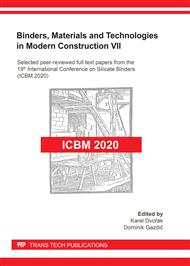p.28
p.34
p.40
p.47
p.53
p.59
p.65
p.71
p.79
Influence of the Chemical Composition of Bauxite on Mineral Formation and Properties of Sulfoaluminate-Ferrite Cement
Abstract:
The influence of the chemical composition of bauxite on the mineral formation and structure of sulfoaluminate-ferrite clinker (SAFC), and physical and mechanical properties of cement based on it is studied. Ferrous bauxite, marble crushing screenings and neutralized fluorine-anhydrite were used for the synthesis of SAFC. The compositions of raw mixes of low-and high-alkaline SAFC are calculated with modular characteristics: Mf (ferritic modulus) = 0.35 and 0.7, Мs (sulfate modulus) = 0.167 and 0.5, respectively. Clinker synthesis from a raw mix containing ferrous bauxite with a quality coefficient of 1.7 must be carried out at a temperature of 1250 °C, which is reduced to 1200 °C for burning a raw mix based on bauxite with a quality coefficient of 2.2. Intensive decomposition of anhydrite occurs with the release of sulfur dioxide into the atmosphere at a temperature of 1300 °C, so it is not recommended to burn SAFC at this temperature. The mineral composition of the obtained SAFC is represented by sulfoaluminate, calcium sulfoferrite and free anhydrite. There is no C2S as a separate phase in clinkers, since in the process of their synthesis belite dissolves in 3С(A,F)·СŜ, mainly in the aluminoferrite phase. The use of bauxite with a quality coefficient of 2.2 in the SAFC raw mix increases the cement activity up to 54.2 MPa. Increasing its specific surface from 350 to 460 m2/kg significantly reduces the setting time of cement paste and increases the strength of sulfoaluminate-ferrite cement both in the early (up to 43.4 MPa) and late hardening periods (up to 67.3 MPa).
Info:
Periodical:
Pages:
53-58
Citation:
Online since:
October 2021
Price:
Сopyright:
© 2021 Trans Tech Publications Ltd. All Rights Reserved
Share:
Citation:


